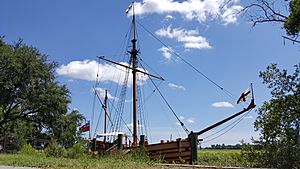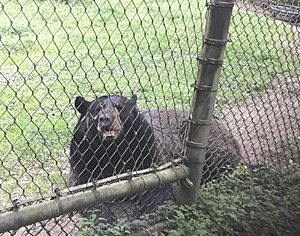Charles Towne Landing facts for kids
Quick facts for kids |
|
|
Site of Old Charles Towne
|
|

Cabin at Charles Towne Landing, August 2016
|
|
| Location | 1500 Old Towne Road |
|---|---|
| Nearest city | Charleston, South Carolina |
| Area | 184 acres (74 ha) |
| Built | 1670 |
| NRHP reference No. | 69000162 |
| Added to NRHP | December 17, 1969 |
Charles Towne Landing State Historic Site is a special place in Charleston, South Carolina. It protects the exact spot where the first English settlers built a permanent town in Carolina. This large park, covering 664 acres, opened in 1970 to celebrate South Carolina's 300th birthday.
Today, the site offers many exciting things to see and do. You can explore an exhibit hall and a natural habitat zoo. There are also ongoing archeological digs, miles of walking trails, and many picnic spots. Visitors can also see a replica tall ship and six replica cannons.
The park once had a special exhibition building called a pavilion. It was designed in 1968 for the tricentennial celebration. There were some delays and problems with its roof, but it finally opened in July 1970. Sadly, the pavilion was damaged during Hurricane Hugo and was later taken down in 2002.
Step Back in Time: Living History at Charles Towne
Charles Towne Landing helps visitors imagine what life was like for the early colonists. Many parts of the park show how people lived and worked hundreds of years ago.
Growing Food: The Experimental Crop Garden
The Experimental Crop Garden shows the kinds of plants early settlers grew. They planted crops for food and to sell for money. You can often see sugarcane and indigo here. These were two important crops that colonists tried to grow for profit. The types of plants you see might change depending on the season.
Sailing the Seas: The Ship Adventure
The Adventure is a copy of a 17th-century cargo ship called a ketch. Ships like this one carried goods, food, and even animals. They sailed between places like New York and Barbados. A famous ship designer named William Avery Baker created the plans for the Adventure in 1969.
The first Adventure ship was at Charles Towne Landing from 1970 to 2004. A new Adventure was built in 2008 in Maine. It then sailed all the way to Charles Towne Landing in October 2008.
Protecting the Settlement: The Fortified Area
The Fortified Area of the park shows how the early colonists defended their new home. It has a reconstructed palisade wall. This wall was built to protect the young colony from attacks by land, especially from the Spanish.
Inside the Fortified Area, you can also see reconstructed earthwork defenses. There are also six replica cannons. The colonists placed some cannons facing the Ashley River. Other cannons protected Towne Creek, which is now called Old Towne Creek. Both the wall and the earth defenses are rebuilt in the same spots where the originals once stood.
Meet the Animals: The Animal Forest
The Animal Forest is a special zoo that shows animals native to Carolina in the 1670s. Some of these animals, like pumas and bison, no longer live in the Low Country of South Carolina today. Here are some of the animals you might see:
Birds of the Carolina Low Country
- Great blue heron
- Brown pelican
- Great egret
- Black-crowned night heron
- White ibis
- Wild turkey
- Turkey vulture
- Black vulture
- Yellow-crowned night heron
Mammals of the Carolina Low Country
- Red wolf
- Striped skunk
- Black bear
- White-tailed deer
- Bison
- Bobcat
- Pumas/cougars/mountain lions
- North American river otter
Uncovering the Past: Archaeology at the Site
Archaeology is the study of human history through digging up old things. At Charles Towne Landing, archaeologists have found many interesting items. These include artifacts from Native American, English, and African people. Professional archaeology at the site began in 1967 and continues even today. These discoveries help us learn more about the first settlers and the people who lived here before them.





